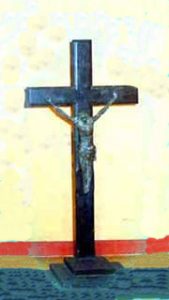In 1887, a young boy named ‘Cogley’ found the figure shown in the image on the right near St Iberius’ Church, in the shallow waters of Lady’s Island lake. 
The story of how the figure ended up in the lake is remembered locally as follows:
One evening in October 1649, a warning came that Oliver Cromwell’s troops were marching towards the church from Wexford to ransack and loot it, along with the nearby pilgrimmage site at Lady’s Island.
On hearing the soldiers were on their way, a local man named ‘Duffy’ ran to St Iberius’ Church and took the crucifix holding this figure from the church. Duffy fled across the shallow part of the nearby lake with the figure in a bid to rescue it from the clutches of the English soldiers.
However, as he made his way across the lake, Duffy was spotted by the soldiers and shot dead. Duffy’s body and the relic he carried fell to the bed of the lake where it was concealed for over 200 years before it was discovered again by chance by the young Cogley in 1887.
The tale was shared with us by Paul Doyle from Our Lady’s Island, who’s great-grandfather was the boy ‘Cogley’ who found the relic in the lake in 1887.
